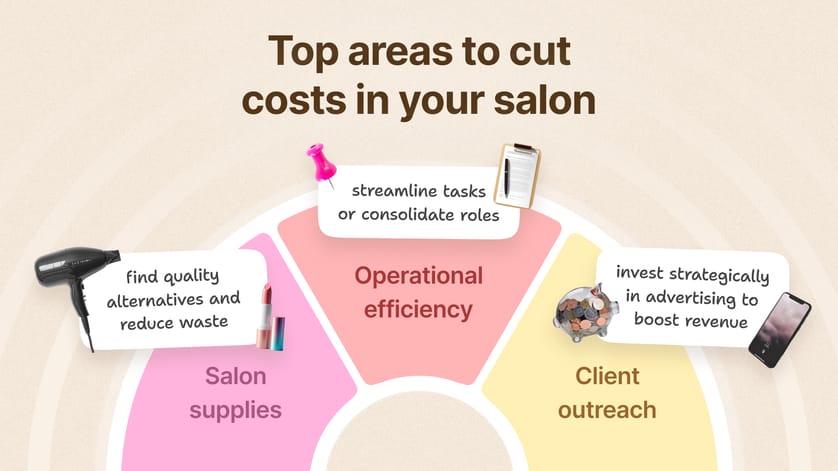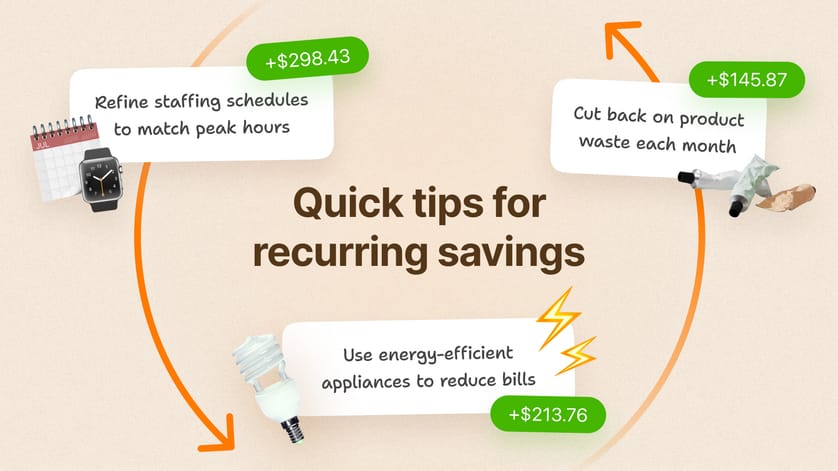Reducing salon costs: effective strategies for expense management
When running a salon business, managing salon expenses is as important as creating that perfect balayage. For many salon owners in the beauty industry, cost-cutting only becomes urgent when the money coming in doesn’t cover the costs going out. Let's break it down: are you dealing with sky-high variable costs on certain services, or are there simply not enough clients to cover your fixed expenses?
These two scenarios call for very different responses.
Before advice... is it really time to talk about reducing salon costs?
Before we jump into the cost-cutting pool, let’s make sure it’s actually filled with water. Cost reduction usually enters the salon owners conversation when revenues aren’t covering the bills. But understanding why this is happening is essential.
Generally, the issue falls into one of two camps:
- High variable costs: this means that the salon expenses tied to delivering each service are too high. Perhaps you’re spending more on salon supplies or labor than the service itself brings in — ouch. In extreme cases, you might even be losing money on some services.
- Insufficient service volume: maybe it’s not your costs, but rather the number of services you're performing that’s the problem. If you aren’t getting enough clients coming through the door to cover your fixed expenses, it’s not time to cut back on salon expenses. Instead, it’s a cue to shake up your business model and focus on client acquisition. Consider this your sign to revisit that “how to attract more clients” guide you bookmarked.
For anyone in the second camp, the advice here is to skip cost-cutting for now and invest your energy in finding ways to boost your revenue. But, if you find yourself in the first group, read on — we’re about to dive into strategic cost reduction for salon expenses that actually makes sense.
Skyrocket your salon’s profits!
Struggling to boost revenue? Our 50 service ideas PDF is packed with creative, high-impact services to fill your salon’s schedule — bank account. Download now to start earning more!
Oh no! We couldn’t subscribe you ☹️
Done! We've sent a link to your Email 📨
Part 1: What costs to reduce?
Some common salon expenses are tough to cut. Sure, you can try to negotiate a lower rent, or skimp on legal and accounting services, but let’s face it — landlords and accountants aren’t usually in the business of doing favors. And cutting wages or utilities? Not so easy, and the payoff might not be worth the effort.
Instead, focus on what you can control:
- Salon supplies: are you paying top dollar for products when there are quality alternatives? Could you reduce waste by using just the right amount, rather than overdoing it?
- Operational efficiency: could you streamline operations, perhaps by consolidating roles or reducing admin hours? This can sometimes save more than penny-pinching on wages or salon supplies.
- Advertising & client outreach: ironically, sometimes the best way to cut costs is to spend a little on strategic advertising to boost revenue. You might get more bang for your buck here than by shaving a few cents off of your utility bill.
Lastly, remember that some savings are about working smarter, not just cheaper. If you’re redirecting your energy efficiently, you might not even need to cut back on salon expenses at all. More on that in Part 3: Make your costs work for you.
One-time vs. continuous savings
When it comes to salon expenses, not all savings are created equal. Depending on your situation, you might opt for a quick, one-time fix or seek smaller, recurring savings that add up over time, which can be especially beneficial for salon owners aiming to maintain financial health in their salon business.
One-time savings
- Cost-efficient renovations: if you’re planning an upgrade to your salon space, consider affordable yet durable materials.You don’t need to splash out on a high-end marble reception desk when something sleeker and cheaper will do.
- Manage excess stock: avoid over-ordering and keep an eye on inventory. Pro tip: Use Suplery to streamline your inventory management process, prevent overstocking, and save some green on salon monthly expenses.
- Opt for ready-made solutions: from website templates to decor, sometimes a well-chosen template or ready-made solution is the way to go. Custom options might be nice, but they’re often pricey.
- Pause non-essential activities: marketing, training, or other non-immediate investments might be worth hitting the brakes on, at least temporarily. This can free up your salon budget for more urgent fixed and variable expenses.
Ongoing savings
Recurring reductions can be golden. Think of them as little gifts to your bottom line each month. By refining product usage, streamlining staffing, and sticking to a shopping list, you’ll keep salon costs from creeping back up.
For comparison: one-time savings like negotiating a better price for a renovation might save you $500-$800 in one go. It’s great, but it’s a one-time deal. In contrast, recurring savings — such as cutting back $100 per month by reducing product waste or refining schedules — will save you $600 in just six months and $1,200 over the course of a year. Over time, these recurring reductions deliver consistent, meaningful impacts to your profit margins without requiring repeated big efforts.
With this approach, you’re setting the stage for more efficient operations without compromising service quality. In Part 2: Best practices of salon cost reduction, we’ll dig into the nitty-gritty of how to make these strategies work for beauty salon owners.
Part 2: Best practices of salon cost reduction
Reducing salon expenses isn’t just about slashing monthly expenses—it’s about being smart with the resources you have. And the first step to cut costs? Knowing exactly where your money is going.
Track your costs religiously
Before making any adjustments, you need a crystal-clear view of your financial health. Many salons don’t fully track their monthly expenses, which makes cost reduction a guessing game. To stay informed, break down your salon expenses by category (rent, products, wages, etc.) and calculate the marginal income of each service. This means considering the product and labor costs for every service versus its price.
Example: If you offer a manicure for $50 but spend $35 on products and wages, that’s a slim $15 profit. Is that service really worth keeping, or should you raise the price, reduce discounts, or cut it altogether?
Use salon software to automate this process. You’ll get real-time insights into which services are performing and which are dragging you down.
Trim the fat: evaluate services and optimize schedules
Let’s face it, not all services are created equal. If a service consistently loses money, it’s time to cut it or optimize it for profitability. It could mean increasing the price, cutting discounts, or using less product. Analyze your schedule too. For instance, if you’re open during hours when walk-ins are rare, is it worth paying your staff to sit around and drive up your salon expenses?
Example: A salon owner might find that their weekday evening hours don’t generate enough revenue to justify staying open. By closing earlier and rebooking clients for busier hours, they save on labor costs without losing business.
Minimize product waste and look for alternatives
Salon products are often an overlooked source of waste and a big contributor to monthly expenses. Start tracking how much product you’re using per service and whether it aligns with your expectations. Are stylists using more than necessary? Could a lower-cost brand provide the same quality?
Example: Our client's hair salon realizes they are wasting tons of hair dye by mixing too much for each client. By reducing the amount they mix based on service, they save a significant portion of their hair salon monthly expenses. Likewise, switching to a quality brand with lower costs can save even more overtime without sacrificing results.
Get friendly with your suppliers
Don’t be shy — negotiation is your friend. Reach out to your suppliers and ask for discounts or favorable terms on salon supplies to lower costs. Here’s a structured approach:
- Do your research. Before negotiating, compare what other vendors offer for similar products. This strengthens your position when you ask for a better deal.
- Build long-term relationships. Suppliers value loyalty. If you've been a regular customer, remind them of this. Long-term partnerships can lead to better pricing and favorable terms, helping salon businesses with fixed and variable expenses.
- Leverage bulk orders. Larger, less frequent orders often unlock bulk discounts. If you can consolidate your purchases, you'll not only save on product costs but also on shipping fees.
- Offer commitment. Show you’re committed to continuing your business with them. Phrases like “If I commit to ordering regularly for the next 12 months, could we discuss better pricing?” can go a long way.
- Ask for extras. If discounts aren’t on the table, ask for other perks like free shipping, longer payment terms, or product samples.
- Use Suplery to streamline communication. Suplery makes negotiating and ordering easier by providing direct communication with suppliers on a single platform. Compare prices, negotiate deals, and order in bulk — saving you time and money while ensuring you’re getting the best offers available.
As they say, the squeaky wheel gets the grease — don’t be afraid to ask for a deal.
Embrace water and energy efficiency
Eco-friendly practices can lead to lower bills and are great for marketing to eco-conscious clients. Simple changes — like installing low-flow faucets and energy-efficient appliances — can significantly reduce monthly utility costs.
Did you know that LED bulbs use up to 75% less energy than traditional incandescent lighting and last much longer? This not only reduces energy costs but also cuts down on maintenance and replacement costs.
Example: A salon that switches to LED lighting and installs water-efficient fixtures sees a 20-30% reduction in utility bills within a few months. On top of that, they promote these changes to eco-conscious clients, attracting a customer base that values sustainability.
Implementing these eco-friendly upgrades not only saves money but also positions your salon as a forward-thinking, responsible business in the eyes of your clients.
Review subscriptions and cut the fluff
We’ve all been there — paying for a subscription we forgot we had. Take the time to audit your recurring subscriptions. Are you using every tool or service you’re paying for? If not, it’s time to cut ties.
You'll be amazed at how quickly these unexpected expenses add up, impacting your nail salon monthly expenses or overall salon expenses.
Example: Our client's small business realizes they're shelling out for a premium social media tool but only using its basic features, which could be handled by a free version. By downgrading, they save $100 per month without losing marketing effectiveness — a smart way to spend money. Check your own subscriptions; you might find a similar opportunity to reduce costs and boost your business success.
Shop with intention
It’s easy to get carried away with purchases when you don’t have a clear list of what you need. Avoid “just in case” purchases, and make it a habit to shop online, where it’s easier to compare prices and stick to your list. By buying only what you’ll actually use, you can avoid the clutter and unnecessary salon expenses that come from ad hoc buying.
Example: Our another client's salon used to stockpile products “just in case,” but after a cash flow crunch, they adopted a strict inventory system using Suplery. By only purchasing what they knew they’d use, and sticking to online orders where they could compare prices, they cut down on waste and freed up cash for other priorities. Check your own inventory — maybe it’s time to cut down on over-ordering and keep that cash flow healthy.
By implementing these best practices, you can create a leaner, more efficient operation that doesn’t sacrifice quality. It’s about finding that sweet spot where every dollar spent brings real value to your salon business and your clients. And when you’re ready to streamline your inventory management and ordering, tools like Suplery can help you stay on track without the headaches of overstocking or scrambling for last-minute supplies.
Part 3: Make your costs work for you
Not all savings mean spending less. Sometimes, it’s about getting more value from the same business expenses. Here are a few ways to maximize the return on your beauty salon expenses:
Invest in client retention
Client retention is one of the easiest ways to maintain a steady revenue stream without having to constantly attract new customers. Prioritizing expenses that enhance client loyalty can pay off in the long run. Here's how you can apply this:
- Start a loyalty program: offer rewards for repeat business, such as a free service after a certain number of visits or discounts for clients who book regularly. Use an app or a simple punch card system for easy tracking.
- Offer exclusive perks: these could include early access to new services or products, complimentary upgrades, or birthday discounts. These perks create a sense of value that keeps clients coming back.
What to do: Create a simple system to track repeat visits. Make sure to promote these loyalty perks on your social media and during checkout, so clients are aware.
Optimize your bonus structure
Your team is your biggest asset, and when they’re invested in the business’s success, everyone wins.
- Tie bonuses to cost-saving goals: set goals like reducing product waste, improving upsell rates, or hitting specific revenue targets. For example, offer a bonus to your stylists if they consistently upsell treatments like deep conditioning or color gloss.
- Encourage energy and product efficiency: motivate your team to be more mindful of water and energy use, or challenge them to use products efficiently by measuring exact amounts during services.
What to do: Set specific, trackable goals for your team. Offer quarterly bonuses or rewards when these goals are met, and provide training on upselling techniques or waste reduction strategies.
Use lean-time discounts
There’s no avoiding quiet times in a salon business, but you can make the most of them by offering discounts during slower periods.
- Create a midday or midweek discount: offer a special rate for services booked between certain hours or days when foot traffic is lower. You can promote this through your social media and email newsletters, highlighting it as a limited-time offer.
- Referral programs: ask your current clients to spread the word and reward them for bringing in friends, especially during these off-peak hours.
What to do: Analyze your appointment calendar to find the slowest hours or days, then build a promotion around those times. Promote it heavily to make sure clients know about the offer.
Host events and workshops
Special events and workshops can help you connect with clients and bring in new revenue.
- Offer how-to classes: host a styling or makeup class where attendees learn a few techniques they can try at home. Charge for attendance and offer discounts on related products or follow-up services.
- Create themed events: these could be bridal hair workshops, prom makeup tutorials, or a “girls' night out” event. Make it fun and social, and offer package deals for participants who book follow-up services.
What to do: Start by choosing a theme for your workshop or event, then promote it online and in-store. Partner with local influencers or businesses to spread the word, and be sure to have product promotions ready for attendees.
Partner with local businesses
Teaming up with nearby businesses allows you to expand your client base without spending a fortune on advertising.
- Joint promotions: collaborate with a boutique, café, or yoga studio to offer package deals. For instance, a “self-care” package could include a yoga class and a blowout at your salon.
- Cross-promote: place flyers in each other’s establishments and promote one another on social media. If you’re in a shopping area, this is a great way to get foot traffic from people who may not have known about your salon.
What to do: Identify a local business that shares your target audience. Reach out with a simple proposal to cross-promote or build a package together. Keep the promotion clear and valuable for both businesses.
By focusing on these areas, you’ll ensure that every dollar you spend is put to good use, supporting not just your immediate needs but also your salon’s long-term success. Ultimately, every dollar saved can help you reinvest in what truly matters: providing an outstanding experience for your clients.
Key takeaways
✅ Reducing costs starts with understanding your salon expenses — differentiate between fixed and variable expenses to prioritize cost-saving efforts effectively.
✅ Salon owners should regularly track salon monthly expenses to gain a clear view of business expenses and maintain financial health in their beauty salon.
✅ For a successful salon business, balance monthly expenses by focusing on controllable costs like supply costs, utility costs, and other common salon expenses.
✅ Implement a salon budget that covers both fixed expenses (rent, utilities, insurance premiums) and variable expenses (products, staffing), helping you cut costs where possible without sacrificing quality.
✅ Investing in salon software like Suplery can streamline financial management, automate tracking, and help you avoid unexpected expenses, enhancing business performance.
✅ Prioritizing expenses and optimizing service efficiency can improve profit margins — identify services with low profitability and consider adjustments to service fees or usage of salon supplies.
✅ For business success, consider both one-time savings, like efficient renovations to salon space, and ongoing savings like minimizing product waste and utility expenses.
✅ Build strong supplier relationships for bulk purchasing and negotiate favorable terms on professional products to lower costs and increase gross income.
✅ Successful salons maximize revenue through client retention strategies, optimizing service hours, and using effective marketing efforts without overspending on marketing budgets.
✅ Look for eco-friendly options for lighting, air conditioning, and water efficiency to reduce utility bills and appeal to eco-conscious clients, positively impacting your taxable income and operational costs.
✅ Audit subscriptions and only spend money on what adds real value to your business model. Cut unnecessary subscriptions and reinvest savings into areas that drive salon's potential.
✅ Small changes, such as switching to energy-efficient hair dryers and using resources effectively, contribute to a busy salon atmosphere and enhance overall business performance.
✅ Review bank statements and allocate funds based on financial goals. By keeping a close eye on spending, salon owners can better navigate tax season and reinvest wisely in business success.
Finally…
So, there you have it: the cost-saving toolkit every salon owner needs. It’s not about sacrificing quality or pinching pennies — it's about getting smart with your expenses. Whether you're trimming service offerings, reworking your bonus system, or leveraging Suplery to master your inventory, each step brings you closer to a lean, mean, profit-generating machine. Now, go on and put those dollars to work. Your salon (and your bottom line) will thank you!
 The latest articles and industry insights delivered to your inbox
The latest articles and industry insights delivered to your inbox
Subscribe to receive a monthly digest of our most valuable resources like blog posts, whitepapers, and guides.
Oh no! We couldn’t subscribe you ☹️
Done! You've subscribed 💛
Unsubscribe anytime. Your data is stored for business-to-business communication purposes. See our Privacy policy.
Frequently asked questions
What are the best ways to reduce costs without sacrificing quality?
Focus on controllable expenses like supply costs and utility bills. Consider negotiating with suppliers, minimizing product waste, and using energy-efficient lighting. Smart choices here keep salon expenses down while maintaining the quality your clients expect.
How can salon owners track monthly expenses effectively?
Salon software simplifies expense tracking, breaking down expenses for clearer budgeting. With automated tracking, salon owners can monitor monthly expenses like rent, products, and wages, helping you stay on top of financial health.
What’s the difference between fixed and variable salon expenses?
Fixed expenses are recurring costs like rent and utilities, while variable expenses fluctuate with service volume, like products and hourly wages. Knowing both helps salon owners prioritize expenses and find savings where possible.
How can I control supply costs for my beauty salon?
Track salon supplies used per service, reduce waste, and look for quality but cost-effective product alternatives. Partnering with suppliers for bulk discounts can also help salon owners lower supply costs.
How can salon software improve business performance?
Salon software tracks salon expenses in real-time, helps manage bookings, and provides insights on what’s profitable. It’s an invaluable tool for salon owners looking to optimize operations and maintain a successful beauty salon.
How do I decide which expenses to prioritize in my salon budget?
Focus on essential business expenses like rent, supplies, and staff wages. After covering fixed expenses, prioritize variable expenses with direct client impact, like professional products. Cutting unnecessary subscriptions and non-essentials also keeps the salon budget lean.
Are loyalty programs effective for salon businesses?
Absolutely. Loyalty programs increase client retention, providing steady income and reducing the need for constant client acquisition. This boosts business success without driving up marketing budgets.
Last updated on Nov 11, 2024
“What Changed” in this article? Everything. It's packed with the latest findings, the ripest data, and a fresh analysis you won't find anywhere else.
A subject-matter expert wrote the content, and reliable, official sources support it. Recent research has been incorporated to maintain relevancy and accuracy.
Please share this post
Table of Contents
Before advice... is it really time to talk about reducing salon costs?Part 1: What costs to reduce?One-time vs. continuous savingsPart 2: Best practices of salon cost reductionPart 3: Make your costs work for youKey takeawaysFinally…Frequently asked questionsHow to promote your hair business on Instagram: expert tips
Discover expert tips to promote your hair business on Instagram. Learn strategic approaches, effective hashtags, engaging content ideas, and Instagram's features for success. Elevate your salon's online presence and attract a wider audience.
Salon marketing
8 min
From appointment to amazing: techniques for a stellar salon experience
Want to make your salon a favorite spot for clients? Learn practical tips to enhance their experience, from pre-appointment communication to adding luxurious touches. Improve satisfaction, retention, and revenue with these straightforward strategies.
Salon client management
6 min
Cut inventory costs in salon: save on salon inventory & optimize stock
Unlock the secrets to slashing salon inventory costs! Boost profits by 10–15% with expert strategies and game-changing techniques to optimize stock and save thousands yearly.
Inventory management in beauty business
14 min
Unlock FREE bonus material!
Get your hands on "50 sample service ideas to boost salon revenue". Subscribe to our newsletter and receive a link to download it straight to your inbox.
Oh no! We couldn’t subscribe you ☹️
Done! We've sent a link to your Email 📨
Trusted by the best in the beauty industry.
Transform your beauty business with Suplery!
Already enjoying our expert tips? Take the next step and join Suplery to revolutionize your business operations.
Huge range of professional products
One-click checkout after first order
Automated predictive orders
Seamless inventory management
From words to action
Start working with Suplery and explore all the tools and services you need to expand your business
Get started with Suplery24/7 Support
Secure payments
Designed by industry’s experts









